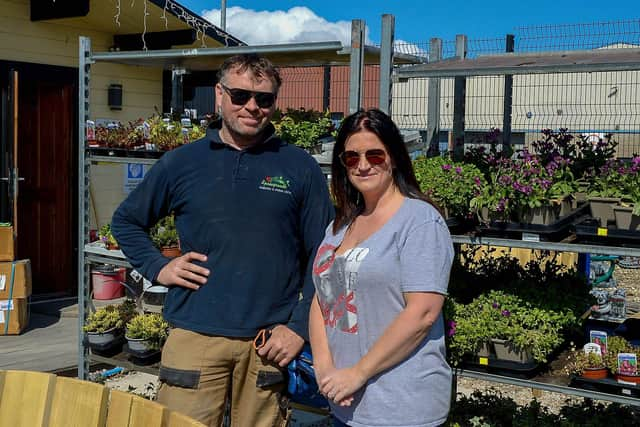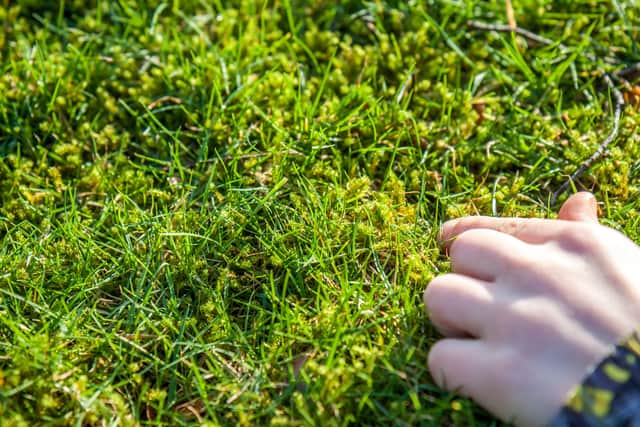Derry Gardeners’ Corner: Treating moss in the lawn
and live on Freeview channel 276
The main causes for moss in our lawns are acidic soil (low pH), shade and poor drainage. Our damp climate doesn’t help either.
They say that prevention is always better than cure and this is the case too when installing a lawn.
Advertisement
Hide AdAdvertisement
Hide AdSo, to begin with, make sure the soil is of good quality. Some suppliers will add sand or grit and this makes the soil more open and loose and also helps with drainage.


There’s not a lot that can be done about high walls and buildings, fences and hedges and existing trees casting shade most of the day. But you can choose where to plant trees and trees with a low, heavy canopy are going to cast more shadow.
To get rid of moss in a lawn it first needs to be treated with either Sulphate of Iron or one of the ‘3 in 1 feed, weed and moss killer treatments’ (which contain Sulphate of Iron).
This is best applied with a lawn spreader for even coverage.
Advertisement
Hide AdAdvertisement
Hide AdTry to avoid getting any on concrete or paved areas as it leaves a rusty looking stain and can be quite hard to remove.


It usually takes just a couple of days to see the results. Unless we get a dry spell then I suggest giving the lawn a sprinkle to get the treatment working.
You will see visible results very quickly when the moss starts to blacken.
The next job is the hardest part; removing the dead moss. The two ways to do this are either with a grass rake or you can hire a scarifier.
Advertisement
Hide AdAdvertisement
Hide AdThe rake method is hard work and you can guarantee blistered hands.
The scarifier is the easier option.
It drives like a lawn mower across the lawn and instead of a blade like a mower it has little wire teeth like a rake which tear up the moss thatch.
The first time you scarify a lawn you will be amazed at the amount of moss you collect and also how little grass there actually is in the lawn. You might also say ‘what the hell was I thinking?’ Because it will look awful for a couple of weeks!
The next part is to sow grass seed through what’s left of the lawn to fill out the bald patches.
Advertisement
Hide AdAdvertisement
Hide AdI would also add a scattering of sand or fine topsoil too and give it a light raking.
This is to hide the seed and stop the pigeons having a picnic.
This is traditionally done between May and September because grass seed will germinate better during these months.
Scarifying can seem like an extreme method and not one you want to have to keep repeating, but it will be if you don’t try to either let more light in by trimming hedges and trees, or improving soil quality.
Advertisement
Hide AdAdvertisement
Hide AdThe soil can be improved by spiking the lawn with either a garden fork or an aerator and brushing in coarse sand into the holes.
You could also use a hollow tine machine, which green keepers would use on golf courses, and this works by pulling out little plugs of soil as you push it along.
Again, you would fill these plugs by brushing in sand or by digging tracks for drains and filling them with two inch gravel, perforated pipe and covered in a layer of soil.
Always remember to dig in the direction of the lowest point of the garden or towards a manhole, as the excess water will need somewhere to run away to.
Advertisement
Hide AdAdvertisement
Hide AdWe have a new product in our garden centre which we are looking forward to using - it’s called Eco Egg Shell Soil Conditioner.
It’s an organic product and simply made of crushed eggshell and seaweed.
It works by raising the pH of the soil, which reduces moss growth and also feeds the grass, which gives a greener, thicker sward.
Personally, I don’t like moss in a lawn, but I don’t mind ‘weeds’ such as dandelion, daisies, clover and buttercup because these are an important source of food for bees.
Advertisement
Hide AdAdvertisement
Hide AdDandelion, especially, are one of the earliest to flower when there is little else on offer in early Spring.
So I prefer not to use the feed, weed and moss killer and just use Sulphate of Iron on its own.